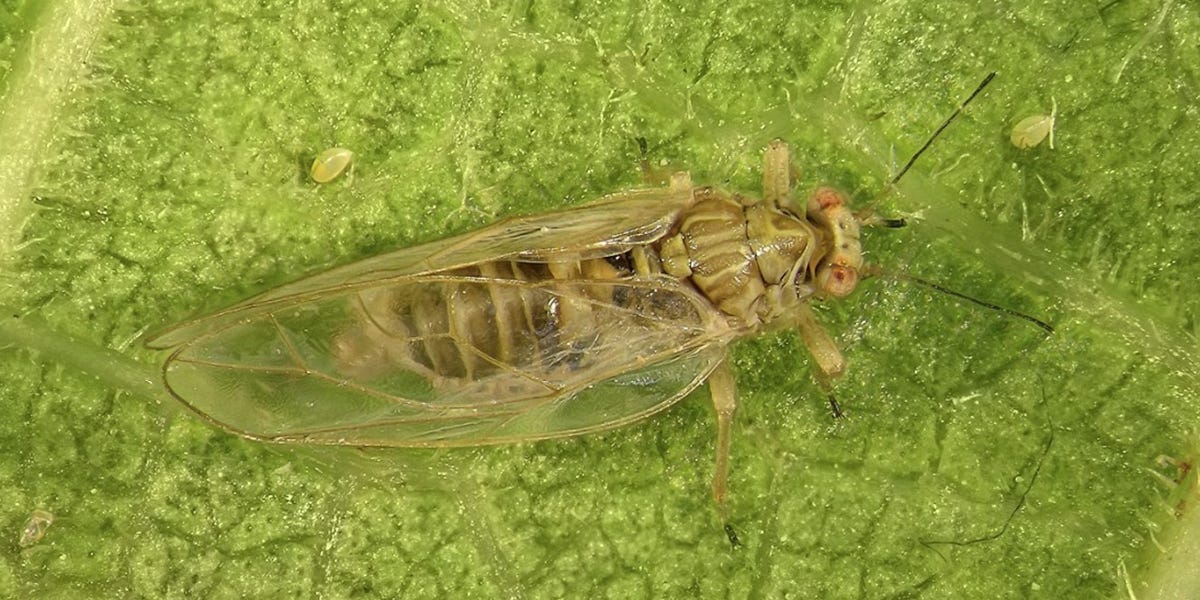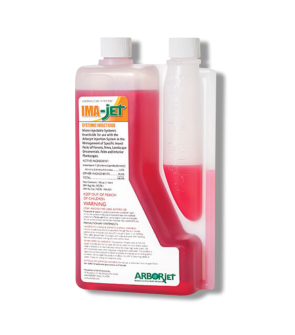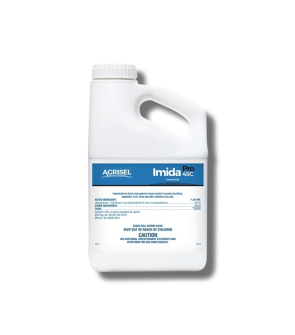Psyllid Control
Most Effective Products
Psyllid Control: How to Get Rid of Psyllids
This page is a general psyllid control guide. Using the products and methods suggested you will get control of psyllids infesting your property. Follow this DIY guide and use the recommended products and we guarantee complete control of present and future infestations of psyllids.
A tiny insect that homeowners may come across in their outdoor foliage is the psyllid, more commonly referred to as jumping plant lice. As suggested by their name this pest uses its powerful hind legs to jump and fly across short distances. To travel great distances the psyllid normally latches itself into the cracks and crevices of plant bark and leaves of field grown container plants or food such as pears.
Though this pest infestation is uncommon, it does not unnoticed throughout the United States due to the export of fruits and other plants from foreign countries. While there are 160 types of species the psyllid can range between two feeding types: monophagous meaning psyllids feast on one type of plants or oligophagous feeding on two or more related plant species. Regardless of their feeding style, the psyllid should be regarded as a serious pest since these pests possess toxic saliva and can form large groups to suck the nutrients out of desired plant tissue.
In small numbers, the psyllid does not pose much of a threat to gardens and foliage. However, in as little as three weeks this pest complete their life cycle and reproduce up to 800 eggs once per generation during the spring and summer months. Follow our DIY treatment guide to learn more about this sap-sucking pest and how to best remove them from your yard by using the recommended steps and products.
Identification

Before you can proceed with a treatment program, you will need to be certain that the pest infesting your property is a species of psyllid. Due to the numerous amount of species, this section will focus on the general characteristics of psyllids. Refer to the following characteristics to identify psyllids.
- Psyllids have short, segmented antennae and elongated oval shaped bodies.
- Similar to cicadas with the exception that psyllids ranges between 0.05 to 0.2 inches in length whereas cicadas measure 1 inch or greater in size.
- During their adult stage, the wings are held in roofline position. Young psyllids are more prone to jumping whereas older psyllids fly.
- Normally tan in color, but can darken to reddish brown as they mature. In the nymph stage, they are pink, green, to yellow in color.
- Psyllids possess a tubular shaped sucking mouthpart to penetrant plant tissue.
- Eggs are orange to yellow in color, 0.3 mm long, and appear football shaped.
Use the image and description above to properly identify psyllids on your property. If unsure then contact us with a photo or sample of your pest through phone, email, or in person at one of our store locations.
Inspection

Once you have confirmed that you are facing an infestation of psyllids, you will then need to locate the areas and plant types they are infesting. Conducting an inspection will help to determine where to focus insecticide applications and the type of product to use. Careless identification can lead you to using the wrong treatment approach and product, which can cost you time and money.
Where to Inspect
Begin by examining aesthetic damages on the leaves, stems, and bark of crops (pears, sweet potatoes, tomatoes, peppers), ornamental plants, trees (acacia, eucalyptus, citrus), and shrubs (grecian laurel) within your garden and landscape.
What to Look For
As a warm dependent pests, the psyllid absorb the juices out of plant leaves with their piercing mouthparts then leave honeydew on which sooty black mold usually grows from throughout the spring and summer season. Depending on the species, they can also leave behind pale or white wax masses, pellets, strands, or coverings called lerps (made from wax and honeydew). From their feeding activity, this causes leaves to turn yellow, burn at top of leaves, holes to develop, curl, and die.
In the first half of spring and summer, psyllids deposit their eggs in the cracks and crevices of plant buds, between plant leaves, tips of new shoot growth, or along the leaf's axis horizontal to the surface. During winter, psyllids overwinter in the cracks and crevices of tree bark and trunks causing slight discoloration or loss of leaves around the area.
Treatment
Once you have confirmed where psyllids are active, you can carry on with insecticide applications. Remember to read the application sites on the product label and plants species to treat, and stay safe before handling or applying any pesticide material by wearing the appropriate personal protective equipment (PPE).
To get rid of psyllids infestations, we recommend using a long-lasting liquid insecticide with a residual effect. For example, Supreme IT is a liquid repellent insecticide labeled to control over 70 types of insects, including Psyllids and the pests that may be attracted to their honeydew excrement's such as ants. Apply Supreme IT only to non-bearing fruit and nut trees, shrubs, ornamental trees, flowers, foliage plants, and lawns. Once applied this product will last on treated areas for up to 90 days to continue to fight against psyllids and other pests.
For citrus tree infestations, apply insecticide products labeled to be used on these plant species such as ImidaPro 4SC. This product is a liquid systemic insecticide that will travel throughout the stem and leaves of the plant for complete protection against psyllids, potato psyllids, and Asian citrus psyllid. Apply only to potatoes and containerized citrus crops including calamondin, citrus citron, citrus hybrids (includes chironja, tangelo, and tangor), grapefruit, kumquat, lemon, lime, mandarin (tangerine), pummelo, orange (sweet and sour), satsuma mandarin, tangelo, white sapote (casimiroa spp.), and other cultivars and/or hybrids of these.
Step 1: Apply Supreme IT to Non-Bearing Fruit and Nut Trees and Ornamental Foliage

Only apply Supreme IT to the leaves, stems, and trunks of non-bearing fruit and nut trees, shrubs, ornamental trees, flowers, foliage plants, and lawns. Do not treat crops and plants with fruit or nuts.
Use a spray volume of 0.25 to 0.5 oz. of Supreme IT per gallon of water per 1,000 sq. ft. Determine how much Supreme IT to use by calculating the square footage of the treatment site. To do this, measure the length and width of the treatment site in feet and multiply together (length X width = square footage). To reach tree canopy heights you will want to use a hose-end sprayer.
Ensure that your water hose pump and the control valve on the hose-end sprayer is turned off. Attach the empty hose-end sprayer to the end of your garden hose. Remove the reservoir from the nozzle to pour in the required amount of Supreme IT. Fill the hose-end sprayer with enough water to treat the entire treatment site. Reattach the nozzle to the filled hose-end sprayer then turn the water hose on. Push forward the control valve switch on the hose-end sprayer until the material is released.
Spray the top and bottom of leaves until wet, but not to the point of excessive run-off. Retreat these sites when 90 days have passed after first application. Keep children and pets off the treatment area until 24 hours have passed or until dry.
Step 2: Treat Containerized or Field Citrus Crops with ImidaPro 4SC

Apply ImidaPro 4SC to potatoes and containerized and field grown citrus crops including calamondin, citrus citron, citrus hybrids (includes chironja, tangelo, and tangor), grapefruit, kumquat, lemon, lime, mandarin (tangerine), pummelo, orange (sweet and sour), satsuma mandarin, tangelo, white sapote (casimiroa spp.), and other cultivars and/or hybrids of these.
Determine how much ImidaPro 4SC to use by measuring the square footage of the treatment site. To do this, measure the length and width of the treatment site in feet and follow the formula (length X width = square footage). The application rate for potato psyllid as a foliar spray is 1.52 oz. of ImidaPro 4SC per 10 gallons of water per acre. Do not exceed 6.4 oz. of product per acre. For complete control, you may need to apply a second application when 7 days have passed from the first application.
For containerized citrus, you will apply 0.37 oz. of product per sufficient water volume per container media as a soil drench or through a low-pressure drip or trickle irrigation water.
For field citrus, apply 8.0 to 16.0 oz. of product per 10 gallons of water per acre. For optimum results, apply to newly planted trees or those previously trained to drip, trickle, or micro-sprinkle irrigation. Pre-wet soil lightly to break soil surface tension prior to application. Soil surface band spray on both sides of the tree. Bands should overlap at the tree base to create a continuous band within the drip-line area of the tree, to be followed immediately with light sprinkler irrigation sufficient to move the product into the upper portion of the root-zone. This method is suitable for very coarse soils with 0.75% organic matter or less. Drench to base of tree not exceeding one-quart total solution per tree immediately around trunk of tree and extending outward covering the entire fibrous root system of the tree. This method is only recommended for trees up to 8 feet tall. Do not exceed 16.0 oz. of product per acre.
Prevention

Once psyllids are removed, you will need to implement some preventative measures to exclude them from your property and eliminate the attractants that draw them to your foliage. Listed below are some preventative measures you can follow to control future psyllids infestations.
- Reapply Supreme IT and ImidaPro 4SC as directed on the product label for continued protection against psyllids.
- Remove affected foliage leaves, stems, and branches to reduce potential psyllid egg hatch sites and stimulate plants to grow.
- Mow turf when it has reached a height of 3 inches and trim back overgrown plant materials to disturb psyllid activity.
- Rake fallen leaves, tree bark, fruit, and branches to reduce moisture and shade in your property and deter psyllids from invading.
- You may use yellow sticky traps along the base of trees, but off the ground to prevent psyllids from climbing up and damaging the plant.
- Avoid overwatering by adjusting watering to once a week early in the morning with no more than an inch of irrigation.
Key Takeaways
What are Psyllids?
- Psyllids are small sucking pests that ingest the plant juices from foliage leaves or fruit depending on the species.
How to Get Rid of Psyllids
- To control psyllids, we recommend using Supreme IT on your lawn, non-bearing fruit and nut trees, shrubs, ornamental trees, flowers, and foliage plants. Apply ImidaPro 4SC to potatoes and containerized and field grown citrus crops including calamondin, citrus citron, citrus hybrids (includes chironja, tangelo, and tangor), grapefruit, kumquat, lemon, lime, mandarin (tangerine), pummelo, orange (sweet and sour), satsuma mandarin, tangelo, white sapote (casimiroa spp.), and other cultivars and/or hybrids of these.
Preventing Psyllid Reinfestation
- Prevent Psyllid infestations by continually applying Supreme IT every 90 days and ImidaPro 4SC no more than two applications for potato psyllids and no more than the maximum application rate for field and containerized citrus crops.














































































































































































































































































































































































































































































































































